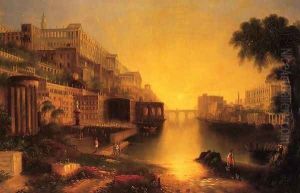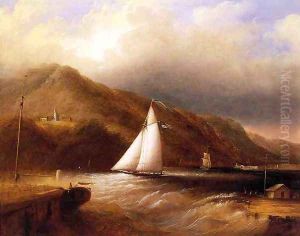Edmund Coates Paintings
Edmund Coates was an American artist, born in 1816, whose career spanned the mid to late 19th century, a period that was marked by significant changes in the art world, including the rise of American landscape painting and the Hudson River School. While not as widely recognized as some of his contemporaries, Coates made notable contributions to the American art scene, primarily through his landscape and portrait paintings. His works are characterized by their detailed realism and often captured the natural beauty of the American landscape, reflecting the broader interest in nature and exploration of American identity during his time.
Coates' early life and training are not extensively documented, but like many artists of his era, he likely apprenticed with established painters and possibly attended one of the few art academies that existed in the United States at the time. The mid-19th century was a period of burgeoning American nationalism, and art played a significant role in shaping the country's cultural identity. Coates, through his artistic endeavors, participated in this cultural project, focusing on themes that were quintessentially American.
Throughout his career, Coates exhibited his work in various venues, including the National Academy of Design, an institution that was central to the development of American art in the 19th century. His landscapes, in particular, were well received, and he was known for his ability to capture the light and atmosphere of his scenes with a remarkable degree of realism. This skill made his works popular among patrons who sought to celebrate and memorialize the American wilderness, which was increasingly seen as a symbol of national pride and identity.
Despite his contributions to American art, Edmund Coates remains a relatively obscure figure in art history. His death in 1871 marked the end of a career that, while not groundbreaking, was emblematic of the broader trends in American art during his lifetime. Coates' works are preserved in several museum collections, serving as a testament to the skill and dedication of an artist who captured the spirit of his age. His legacy, though modest, is part of the rich tapestry of 19th-century American art, offering insight into the era's aesthetic values and its evolving sense of national identity.

